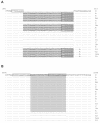Recombination in the genome of Chlamydia trachomatis involving the polymorphic membrane protein C gene relative to ompA and evidence for horizontal gene transfer
- PMID: 15205432
- PMCID: PMC421610
- DOI: 10.1128/JB.186.13.4295-4306.2004
Recombination in the genome of Chlamydia trachomatis involving the polymorphic membrane protein C gene relative to ompA and evidence for horizontal gene transfer
Abstract
Genome sequencing of Chlamydia trachomatis serovar D has identified polymorphic membrane proteins (Pmp) that are a newly recognized protein family unique to the Chlamydiaceae family. Cumulative data suggest that these diverse proteins are expressed on the cell surface and might be immunologically important. We performed phylogenetic analyses and statistical modeling with 18 reference serovars and 1 genovariant of C. trachomatis to examine the evolutionary characteristics and comparative genetics of PmpC and pmpC, the gene that encodes this protein. We also examined 12 recently isolated ocular and urogenital clinical samples, since reference serovars are laboratory adapted and may not represent strains that are presently responsible for human disease. Phylogenetic reconstructions revealed a clear distinction for disease groups, corresponding to levels of tissue specificity and virulence of the organism. Further, the most prevalent serovars, E, F, and Da, formed a distinct clade. According to the results of comparative genetic analyses, these three genital serovars contained two putative insertion sequence (IS)-like elements with 10- and 15-bp direct repeats, respectively, while all other genital serovars contained one IS-like element. Ocular trachoma serovars also contained both insertions. Previously, no IS-like elements have been identified for Chlamydiaceae. Surprisingly, 7 (58%) of 12 clinical isolates revealed pmpC sequences that were identical to the sequences of other serovars, providing clear evidence for a high rate of whole-gene recombination. Recombination and the differential presence of IS-like elements among distinct disease and prevalence groups may contribute to genome plasticity, which may lead to adaptive changes in tissue tropism and pathogenesis over the course of the organism's evolution.
Figures






References
-
- Blot, M. 1994. Transposable elements and adaptation of host bacteria. Genetica 93:5-12. - PubMed
-
- Caldwell, H. D., H. Wood, D. Crane, R. Bailey, R. B. Jones, D. Mabey, I. Maclean, Z. Mohammed, R. Peeling, C. Roshick, J. Schachter, A. W. Solomon, W. E. Stamm, R. J. Suchland, L. Taylor, S. K. West, T. C. Quinn, R. J. Belland, and G. McClarty. 2003. Polymorphisms in Chlamydia trachomatis tryptophan synthase genes differentiate between genital and ocular isolates. J. Clin. Investig. 111:1757-1769. - PMC - PubMed
Publication types
MeSH terms
Substances
Grants and funding
LinkOut - more resources
Full Text Sources
Other Literature Sources

